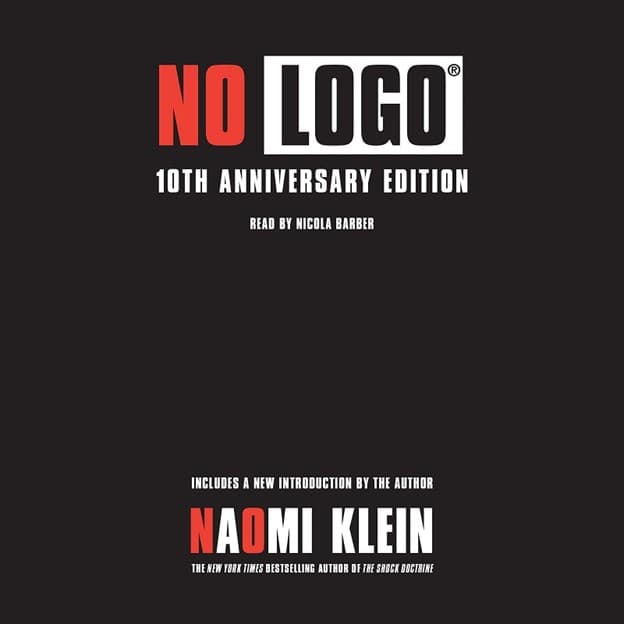No Logo Summary
خلاصه کتاب بدون آرم
1-Sentence-Summary: No Logo uses four parts, including “No Space,” “No Choice,” “No Jobs,” and “No Logo,” to explain the growth of brand power since the 1980s, how the focus of companies on image rather than products has affected employees, and to identify those who fight against large corporations and their brands.
خلاصه کتاب بدون آرم (بدون لوگو) در یک جمله: کتاب No Logo (بدون مارک) از چهار بخش شامل «بدون فضا»، «بدون انتخاب»، «بدون شغل» و «بدون لوگو» برای توضیح رشد قدرت برند از دهه ۱۹۸۰ استفاده میکند. همینطور این که چگونه تمرکز شرکتها روی تصویر، بهجای محصولات، کارکنان را تحت تاثیر قرار داده و شناسایی کسانی که با شرکتهای بزرگ و برندهایشان مبارزه میکنند را نشان میدهد.
Favorite quote from the author:
نقلقول مورد علاقه نویسنده:
It’s virtually impossible to go anywhere and not see a logo. Advertisements and brand names constantly bombard us in our daily lives. Pretty much everyone knows Google, Nike, McDonald’s, and Disney. And the more these companies grow, the more power and influence they gain.
تقریبا غیرممکن است که به جایی بروید و لوگویی نبینید. تبلیغات و نامهای تجاری، مدام ما را در زندگی روزمره بمباران میکنند. تقریبا همه، گوگل، نایک، مک دونالد و دیزنی را میشناسند. و هر چه این شرکتها بیشتر رشد کنند، قدرت و نفوذ بیشتری هم کسب میکنند.
Around the turn of the century, a new era of globalization arrived, meaning big brands expanded and became bigger than ever. This equated to bigger-than-ever profits and a huge wave of outsourcing. Soon, there were poor working conditions and environmental ruin.
در اواخر قرن، عصر جدیدی از جهانی شدن فرا رسید، به این معنی که برندهای بزرگ گسترش یافتند و بزرگتر از همیشه شدند. این بهمعنای سود بیشتر از همیشه و موج عظیمی از برونسپاری بود. خیلی زود شرایط کاری بد و ویرانی محیطی به وجود آمد.
International best-seller No Logo: Taking Aim at the Brand Bullies is Naomi Klein’s manifesto on the negative effects of globalization and big brands. It may have been published in 1999, but the ideas still remain important and relevant 20 years later. In her book, she uncovers the exploitative labor practices and sinister marketing techniques of multinational companies and inspires us to fight back.
کتاب پرفروش «بدون لوگو: هدف گرفتن قلدرهای برند» بیانیهی نائومی کلاین در مورد تاثیرات منفی جهانی شدن و برندهای بزرگ است. ممکن است این کتاب در سال ۱۹۹۹ منتشر شده باشد، اما این ایدهها همچنان برای ۲۰ سال بعد هم مهم و مرتبط هستند. او در کتاب خود، شیوههای استثمارگرانه کار و تکنیکهای بازاریابی شوم شرکتهای چندملیتی را آشکار میکند و ما را تشویق میکند که در مقابل آنها بجنگیم.
These are 3 of the best lessons the book teaches:
Having a successful brand is more about appearing cool than the actual product itself.
Multinational companies outsource their manufacturing to developing countries and it is bad for the workers there and in the West.
If you want to criticize a multinational giant, try targeting and subverting their brand.
اینها ۳ تا از بهترین درسهایی است که کتاب آموزش میدهد:
۱. داشتن نام تجاری موفق بیشتر به معنای جذاب بودن ظاهر است تا خود محصول واقعی.
۲. شرکتهای چندملیتی تولید خود را به کشورهای در حال توسعه برونسپاری میکنند و این برای کارگران آنجا و در غرب بد است.
۳. اگر میخواهید از یک غول چندملیتی انتقاد کنید، سعی کنید برند آنها را هدف قرار دهید و آنها را زیر پا بگذارید.
Let’s get right to learning!
بیایید سراغ یادگیری برویم!
Lesson 1: Successful brands focus more on brand identity than their actual product.
درس ۱: برندهای موفق بیشتر بر هویت برند تمرکز میکنند تا محصول واقعی خود.
Believe it or not, the best way to have a successful product isn’t making something that’s the highest quality. It’s about making something considered the coolest. That’s why companies spend enormous amounts of money every year trying to figure out what’s cool and incorporating this into their brand.
باور کنید یا نه، بهترین راه برای داشتن یک محصول موفق، ساختن چیزی با بالاترین کیفیت نیست. بلکه در مورد ساخت چیزی است که «جالبترین» در نظر گرفته شود. به همین دلیل است که شرکتها سالانه مبالغ هنگفتی را صرف این میکنند که بفهمند چه چیزی جالب است تا آن را در برند خود بگنجانند.
The reason big brands are so successful is that they concentrate on marketing and research to maintain a specific image. They know that their competitors have cheaper products, so they want to focus on building brand loyalty instead.
دلیل موفقیت برندهای بزرگ این است که برای حفظ یک تصویر خاص بر بازاریابی و تحقیق تمرکز میکنند. آنها میدانند که رقبایشان محصولات ارزانتری دارند، بنابراین در عوض میخواهند بر ایجاد وفاداری به برند تمرکز کنند.
The brands that are the most successful are concept-driven, so they appeal to people on an emotional or spiritual level rather than a rational level. Brands want to be recognized and known for a set of values rather than for whatever product they produce.
برندهایی که موفقترین هستند، مفهوممحورند؛ بنابراین در سطح عاطفی یا معنوی افراد را جذب میکنند تا در سطح منطقی. برندها میخواهند به خاطر مجموعهای از ارزشها شناخته شوند تا این که به خاطر هر محصولشان شناخته شوند.
For example, Nike spends very little money on manufacturing their items when you compare it to how much they spend on sponsorship deals, advertising, and marketing. Because of this, Nike isn’t just a sportswear company, but a company that enhances people’s lives through sports and healthy lifestyles.
به عنوان مثال، شرکت نایکی در مقایسه با معاملات اسپانسر، تبلیغات و بازاریابی، پول بسیار کمی را برای تولید اقلام خود صرف میکند. به همین دلیل، نایکی فقط یک شرکت پوشاک ورزشی نیست؛ بلکه شرکتی است که زندگی مردم را از طریق ورزش و سبک زندگی سالم بهبود میبخشد.
It also has sought to be seen as a company that empowers both women and Black people, which is something far different from a mere sneaker manufacturer.
همچنین به دنبال این بوده است که به عنوان شرکتی در نظر گرفته شود که هم زنان و هم افراد سیاهپوست را توانمند میکند که چیزی بسیار متفاوت از صرفا تولیدکننده کفشهای کتانی است.
Lesson 2: Outsourcing isn’t just bad for workers in developing countries, it’s bad for workers everywhere.
درس ۲: برونسپاری نهتنها برای کارگران کشورهای در حال توسعه، بلکه برای کارگران در همه جای دنیا بد است.
In the 80s and 90s, many big companies began outsourcing to save on labor costs. They closed up factories in Western countries and built new ones in the developing world where the labor is cheaper. Because these workers are considered contractors rather than employees, these multinationals don’t have responsibility for them.
در دهههای ۸۰ و ۹۰، بسیاری از شرکتهای بزرگ شروع به برونسپاری کردند تا در هزینههای نیروی کار صرفهجویی کنند. آنها کارخانهها را در کشورهای غربی بستند و کارخانههای جدیدی را در کشورهای در حال توسعه که نیروی کار ارزانتر است، ساختند. از آنجا که این کارگران به جای کارمند، پیمانکار محسوب میشوند، این شرکتهای چندملیتی مسئولیتی در قبال آنها ندارند.
These factories are usually in Export Processing Zones. These are places where income and export taxes are suspended to make them enticing for businesses. However, these places have no minimum wage or labor laws. This means workers in these places have to endure terrible working conditions and even worse pay.
این کارخانهها معمولا در مناطق فرآوری صادراتی هستند. اینها مکانهایی هستند که مالیات بر درآمد و صادرات به حالت تعلیق در میآیند تا برای کسبوکارها فریبنده شوند. با این حال، این مکانها فاقد حداقل دستمزد یا قانون کار هستند. یعنی کارگران در این مکانها باید شرایط کار وحشتناک و حتی حقوق بدتری را تحمل کنند.
The majority of them are young migrant women. Corporations and governments don’t protect them, so anything goes. They endure unreasonable hours, child labor, no benefits, and wages as low as $0.13 an hour.
اکثریت آنها زنان جوان مهاجر هستند. شرکتها و دولتها از آنها محافظت نمیکنند؛ بنابراین این مسئله قابل قبول است. آنها ساعات غیر معقول، کودکان کار، بدون مزایا بودن و دستمزدهای کمتر از ۰/۱۳ دلار در ساعت را تحمل میکنند.
Outsourcing has also had a negative impact on employees in the Western world. Traditionally, these large companies would employ their own workforce and unionization allowed these employees to have relatively stable and well-paid jobs. Workers felt a loyalty to their employers.
برونسپاری نیز تاثیر منفی بر کارمندان در دنیای غرب داشته است. به طور سنتی، این شرکتهای بزرگ نیروی کار خود را استخدام میکردند و تشکیل اتحادیه به این کارمندان اجازه میداد تا مشاغل نسبتا پایدار و با درآمد خوبی داشته باشند. کارگران هم نسبت به کارفرمایان خود احساس وفاداری داشتند.
But in the 80s, everything changed. Companies became more preoccupied with branding than the products, so they chose to spend money on marketing rather than manufacturing. These manufacturing jobs were then replaced with employment in the service sector. These jobs became known as ‘McJobs,’ and they were usually part-time and minimum wage.
اما در دهه ۸۰ همه چیز تغییر کرد. شرکتها بیشتر به برندسازی مشغول شدند تا محصولات؛ بنابراین ترجیح دادند به جای تولید، برای بازاریابی پول خرج کنند. سپس این مشاغل تولیدی با استخدام در بخش خدمات جایگزین شدند. این مشاغل به «مک جابز» معروف شدند و معمولا پارهوقت و با حداقل دستمزد بودند.
In many of these workplaces, unions are strongly discouraged and work satisfaction is dismal. Employers prefer to go with young employees that require less pay and aren’t as likely to unionize. Long gone are the days when workers felt any loyalty to employers.
در بسیاری از این محلهای کار، اتحادیهها به شدت دلسرد میشوند و رضایت شغلی ناامیدکننده است. کارفرمایان ترجیح میدهند با کارمندان جوانی همراه شوند که به حقوق کمتری نیاز دارند و احتمال عضویت در اتحادیه را ندارند. روزهایی که کارگران احساس وفاداری به کارفرمایان داشتند، مدتهاست که گذشته است.
Lesson 3: If you want to make a difference, you can try targeting specific multinational brands to bring them down.
درس ۳: اگر میخواهید تغییر ایجاد کنید، میتوانید برندهای چندملیتی خاص را هدف قرار دهید تا آنها را پایین بیاورید.
Whether we realize it or not, brands wield an immense amount of cultural power in our society. Persistent brainwashing burned the names and logos of these companies into our minds, making them instantly recognizable. This seems like a great thing for them, but it is also something that can be used against them fairly easily.
چه بدانیم چه ندانیم، برندها قدرت فرهنگی زیادی در جامعه ما دارند. شستوشوی مغزی مداوم، نام و نشان این شرکتها را در ذهن ما گنجانده و آنها را فورا قابل تشخیص کرده است. این یک چیز عالی برای آنها به نظر میرسد؛ اما همچنین چیزی است که میتواند به راحتی علیه آنها استفاده شود.
Brands can be brought down by this omnipresence through criticisms that are attached to their specific brand. Activists can campaign using well-known brand names to draw attention to their cause, severely damaging their image.
برندها را میتوان با این حضور همهجانبه از طریق انتقاداتی که به برند خاص آنها مرتبط است، پایین آورد. فعالان میتوانند با استفاده از نامهای تجاری شناختهشده برای جلب توجه به هدف خود کمپین ایجاد کنند و بهشدت به تصویر آنها آسیب وارد کنند.
Campaigns against sweatshops have been given a boost when they are tied to specific brands. Showing a branded article of clothing and highlighting the adverse conditions workers who make it have to endure brings relevance to Western consumers. They can then boycott the brand until they make conditions better for these workers.
کمپینهای ضد بیگارگاهها (کارگاههایی با شرایط بد کار) زمانی که به برندهای خاص گره خوردهاند، تقویت شده است. نمایش یک کالای مارکدار از لباس و برجسته کردن شرایط نامطلوب کارگرانی که آن را تحمل میکنند، برای مصرفکنندگان غربی اهمیت دارد. آنها میتوانند آن برند را تحریم کنند تا زمانی که شرایط را برای این کارگران بهتر کنند.
Culture jamming is another way of subverting a brand identity. This is where activists use a brand’s dominance in public settings against them. Culture jammers can use things like spray to alter advertisements and branded pictures to show another point of view.
پارازیت فرهنگی راه دیگری برای براندازی هویت برند است. اینجاست که فعالان از تسلط برند در محیطهای عمومی علیه خود برند استفاده میکنند. مسدودکنندههای فرهنگ میتوانند از چیزهایی مانند اسپری برای تغییر تبلیغات و تصاویر برند شده برای نشان دادن یک دیدگاه دیگر استفاده کنند.
They can take a slogan and change it slightly or touch up an image to change the meaning. For example, Nike’s famous slogan ‘Just do it’ can be rewritten ‘Just don’t do it’ or ‘Justice, do it Nike.’
آنها میتوانند یک شعار را بگیرند و کمی آن را تغییر دهند یا یک تصویر را تغییر دهند تا معنی آن را تغییر دهند. برای مثال، شعار معروف نایک «فقط انجامش بده» را میتوان «فقط انجامش نده» یا «عدالت، آن را انجام بده نایکی» بازنویسی کرد.
No Logo Review
مروری بر کتاب بدون لوگو
I’m always a big fan of any book or person with an attitude of let’s tear down the ultra-rich, so naturally, I liked No Logo. The jargon gets a bit much sometimes, but it’s not too bad and I wouldn’t write the book off just for that. It’s definitely an eye-opener that I hope a lot of people will read!
من همیشه از طرفداران پر و پا قرص هر کتاب یا شخصی با نگرش «بیایید ثروتمندان فوقالعاده را نابود کنیم» هستم؛ بنابراین طبیعتا کتاب No Logo را دوست داشتم. گاهی اوقات اصطلاحات کمی زیاد میشود؛ اما خیلی بد نیست و من کتاب را صرفا به آن دلیل نمینویسم. این کتاب مطمئنا چشم را باز میکند که امیدوارم بسیاری از مردم آن را بخوانند!
Who would I recommend the No Logo summary to?
کتاب بدون لوگو را به چه کسی توصیه میکنم؟
The 57-year-old ultra-rich CEO of a multinational company, the 33-year-old who wants to learn more about how the power of big brands has changed in the last few years, and anyone that hopes to find ways to make the world a more fair place.
مدیرعامل فوقالعاده ثروتمند ۵۷ ساله یک شرکت چندملیتی، مرد ۳۳ سالهای که میخواهد در مورد چگونگی تغییر قدرت برندهای بزرگ در چند سال اخیر یاد بگیرد و هر کسی که امیدوار است راههایی برای تبدیل جهان به مکانی منصفانهتر پیدا کند.


